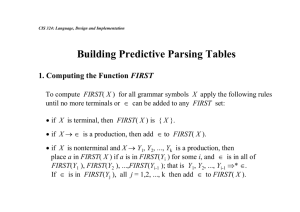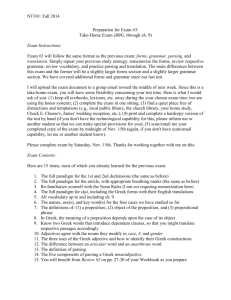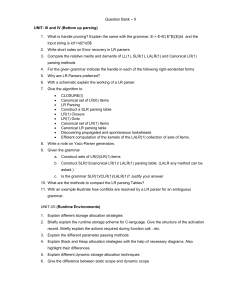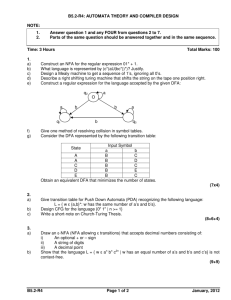CHAPTER 3 LEXICAL ANALYSIS
advertisement
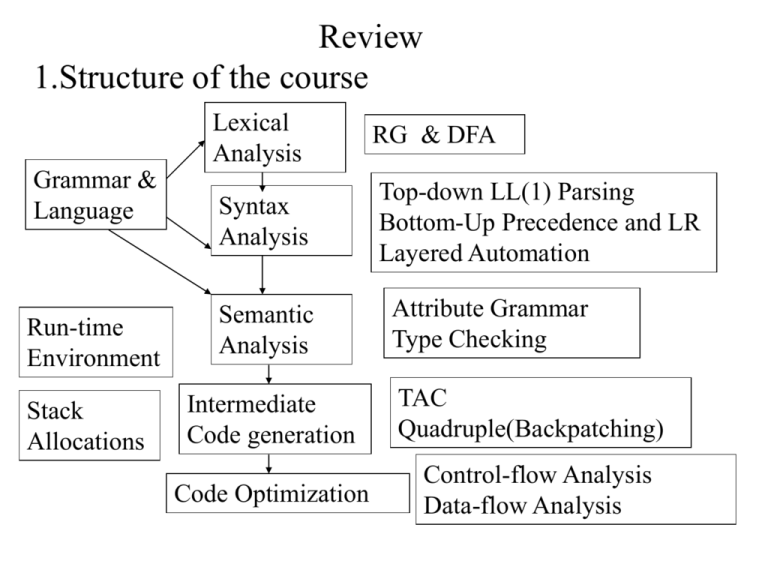
Review 1.Structure of the course Grammar & Language Lexical Analysis RG & DFA Syntax Analysis Top-down LL(1) Parsing Bottom-Up Precedence and LR Layered Automation Attribute Grammar Type Checking Run-time Environment Semantic Analysis Stack Allocations Intermediate Code generation TAC Quadruple(Backpatching) Code Optimization Control-flow Analysis Data-flow Analysis Review 2.Scope of reviewing • From Chapter 2-Chapter 9 Review 3.Methods of reviewing • Understanding basic concept, principles deeply • Being able to do exercises • Understanding the process by drawing the graph or the flow • Remembering after understanding Review 4.Forms of problems in the examination paper • Similar to the exercises finished by you • Without any the form of choosing answers or judgment Review 5.Form of examination • Closed (Cannot refer to any other materials) Review 6.Important knowledge points • Chapter 2 – Chomsky Grammar and related Automation – Construct a context-free grammar without production from a language • All strings of a’s and b’s with an even number of a’s and an odd number of b’s • Strings of a’s and b’s with an equal number of a’s and b’s • Embedded grammar • Combination of regular grammar and embedded grammar Review 6.Important knowledge points • Chapter 3 – Conversion from NFA to DFA • Subset Method – Minimizing of DFA • Top-down partition of equivalent class – Conversion from Regular expression to NFA and inverse conversion – Conversion from Regular Grammar to NFA and inverse conversion – Construct a minimum-state DFA for a regular expression Review 6.Important knowledge points • Chapter 4 – Top-down Parsing • Recursive descent parsing • Predictive parsing – LL(1) • LL(1) Parsing table construction – Elimination of left recursion » First direct, Next indirect recursion – Factoring – First &Follow – Show a CFG grammar is whether a LL(1) grammar by constructing the related parsing table Review 6.Important knowledge points • Chapter 4 – Bottom-up Parsing • LR parsing – SLR(1) -- Follow – LR(1) – Predictive symbol – LALR –Merging states with the same core – Show a CFG grammar is whether a LR grammar by constructing the related parsing table Review 6.Important knowledge points • Chapter 4 – Ambiguous Grammar parsing • Additional conditions – Associated law and precedence – Dangle rules – Parsing an ambiguous grammar in LR parsing method with additional conditions Review 6.Important knowledge points • Chapter 5 – Attribute – Annotated parsing tree • Construct an annotated parsing tree for an expression (S-attribute) – Syntax-directed definition – S-attribute Grammar and evaluation of S-attribute • Construct semantic rules for a S-attribute grammar Review 6.Important knowledge points • Chapter 6 – Type – Type expression • Construct a type expression for a declaration Review 6.Important knowledge points • Chapter 7 – Stack-based storage allocation • Activation Record Form • C language program – Recursive function • Pascal language program – Display • Construct a maximum stack map for a C recursive program Review 6.Important knowledge points • Chapter 8 – TAC – Quadruple – Bottom-up Syntax-directed Program Translation • Assignment statement with array • If and While statement • Translate a program fragment into TAC or quadruple using bottom-up syntax-directed program translation method Review 6.Important knowledge points • Chapter 9 – Block Division • Construct a flow graph from TAC statements sequence – Optimization in a Block • Constant folding • Common sub-expression • Copy-propagation • DAG • Code rewriting • Optimize a block in DAG method and rewrite the code Review 6.Important knowledge points • Chapter 9 – Loop seeking • Back edge • Code Motion • Reduction of strength • Find out the loop in a flow graph using dominators and back edge – Data flow analysis • Why should we analyze the data-flow of a program? • How should we analyze the data-flow of a program? Experiments 1. Lexical Analyzer • Define the set of Regular Expressions of the words • Construct the NFAs • Merge the NFAs into a single NFA • Convert the NFA into a DFA with minimum states • Write the lexical analyzer according to the DFA • Verify the program – Input file: a short source program with the sorts of the words – Output file: the token sequence Experiments 2. Syntax Analyzer (Parser) • Define the Context-free Grammar of the sentences • Construct the LL(1) Parsing Table/LR(1) Parsing Table • Write the monitor program which uses the LL(1) Parsing Table/LR(1) Parsing Table • Verify the program – Input file: the token sequence – Output file: the derivation sequence/reduction sequence Experiments 3. Experiment Report • Topic • Motivation • Requirements • Environments • Ideas • Design of Data Structure & Algorithms • Run results • Main Occurred Problems & Solutions • Feelings • ….
